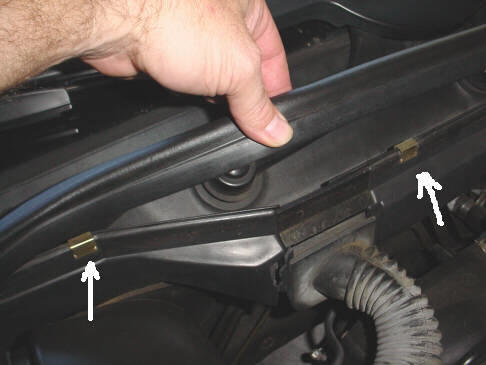Several days ago (today is Friday, August 30, 2002), Jim Cash posted a message on the RoadFly E39 message board regarding the cover over the E-box, and how it is critical to ensure this cover is correctly installed. I'd had this very cover off during a routine inspection several months ago, and Jim's post made me wonder... so I went out to the car to inspect my work.
As it turned out, I had replaced the E-box cover correctly: however, I noticed something else that seemed an even worse situation. The upper cowl piece, right where the harness ducting from the motor enters the cowl, had begun to disintegrate, preventing the ducting from making a tight seal to the cowl.
When I purchased a replacement cowl piece, I was told that several of these pieces had been used by the service department in the last few months alone. So I began to think I might not be the only one with this problem. Hence this page (and page 2, too). My 540 is a 1997 year-model, with only 45k miles. I have no idea why this piece disintegrated, but it must be due to heat.
Parts Needed: New cowl p/n 51-71-8-157-446 (check w/ your dealer to verify!), $26.00. One small screwdriver.
Total time to complete replacement: 50 minutes.
Many thanks to Jim Cash for his help: for leading me to this discovery in the first place; for educating me as to what that "black flex hose" really does; and for helping me find the correct part number in the %$# ETK...

See anything wrong? I didn't until looking for the issue mentioned above. The arrow in this pic shows the damage as visible from this perspective. Not very obvious, is it?



There are a total of seven fasteners holding the cowl on: three brass clips, two of which are shown, along the top edge, and four quick-release cam clips along the bottom edge.




To remove these clips, simply rotate them 90 degrees either way, so that the "handle" is horizontal. They will then come right out.
To reinstall - insert firmly with handle in horizontal position, then twist 90 degrees. You will feel them "snap" into locked position.




Click link below for next page.












